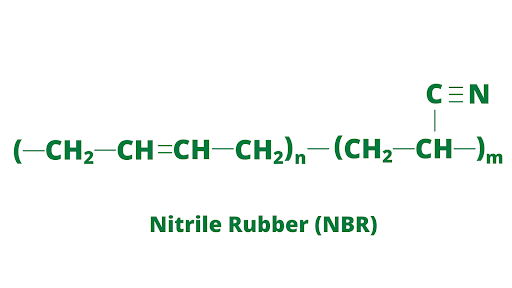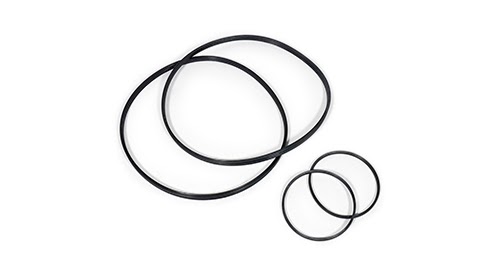Working Temperature Range:
High: 212°F / 100°C
Low: -22°F / -30°C
 What is Nitrile Rubber?
What is Nitrile Rubber?
Nitrile rubber is also called nitrile butadiene rubber, NBR, Buna-N and acrylonitrile butadiene rubber. It is a synthetic rubber, and is usually the ideal choice for any product that requires petroleum (oil or gas) resistance.
This material, like many other synthetic rubbers, gained popularity during World War II when natural rubber resources were in short supply around the globe. Different versions of the same polymer were created in different countries, but the U.S. version of Nitrile rubber was called Buna-N.
Today, Nitrile rubber is used mainly when an application requires a resistance to petroleum. It is a common base for gaskets, O-rings and other types of seals.
If Nitrile rubber is the ideal material for your application, give Custom Rubber a call. Even if you aren’t certain, our team of experts can help guide you. Contact Custom Rubber Corp. for answers to your Nitrile rubber questions.
Discover More Engaging Content and Exclusive Insights by Clicking Here to Explore our YouTube Channel
Advantages of Nitrile Rubber
Nitrile rubber’s biggest advantage is its resistance to petroleum, but it also has several other desirable properties.
- Excellent abrasion resistance
- Good tear resistance
- Low compression set
Disadvantages of Nitrile Rubber
Nitrile rubber is not ideal in applications that require prolonged exposure to ozone or heat. Disadvantages include:
- Poor ozone, weather and sun resistance
- Moderate operating temperature range
- Low flame resistance

Commonly Asked Questions About Nitrile Rubber
The following questions regarding Nitrile rubber applications, properties and uses are frequently asked by our customers. Custom Rubber Corp. is here to provide answers and assist in your decision making process.
Q: What is Nitrile rubber used for?
A: Nitrile rubber is primarily used in applications requiring oil or solvent resistance. Solvents are materials that are oil-based, like paint thinners, turpentine, MEK, etc. Choose Nitrile when your end product will come in contact with these or other oil-based materials.
At Custom Rubber, we have used Nitrile rubber to make bumper pieces that slide along a greased track as well as nitrile rubber seals used for underground conduits. We have also blended Nitrile rubber and PVC plastic to create heavy duty power distribution products, like the wires strung with lights used to illuminate construction sites.
Throughout the industry, Nitrile rubber is often used to create latex-alternative rubber gloves, oil-resistant footwear, floor mats, transmission belts for cars, synthetic leather, V belts and as a component of different adhesives.
Q: Is Nitrile a natural rubber?
A: No, Nitrile rubber is not a natural rubber. It is a human-made, synthetic material. For more information on this topic, we've published an article explaining the difference between natural and synthetic rubber here.
Q: How long does Nitrile rubber last?
A: Nitrile rubber’s lifespan, like nearly all rubber materials, depends on how it is formulated, stored and applied. Nitrile rubber exposed to the elements can have an extremely short life whereas Nitrile rubber kept immoible in a dark storage cabinet will last the longest.
Q: How can I extend the life of Nitrile rubber?
A: Take good care of your Nitrile rubber by keeping it away from ozone, heat, sun and weather. When not in use, store it in an ozone proof bag.
Q: Is Nitrile rubber poisonous?
A: Nitrile rubber is not poisonous, but we would not recommend eating a bowl of it for breakfast. Like many synthetics, you can actually formulate Nitrile rubber with all FDA-approved ingredients, but again, that doesn’t mean it’s great for the human body to digest.
Q: How do I moisturize Nitrile rubber?
A: Strictly speaking, there is no great way to moisturize Nitrile rubber. A Nitrile product outside exposed to ozone will inevitably dry and crack. Instead, buy a new part and keep it out of the sun, or use a different type of rubber if the part must stay exposed to sunlight.

Q: Where are Nitrile rubber gloves used?
A: Nitrile rubber can be used in place of natural rubber latex to create rubber gloves if the user is allergic to latex. Nitrile rubber is also much more puncture-resistant than natural rubber, making it an ideal alternative in situations where rubber gloves risk tearing or breakage.
Q: What is the difference between Nitrile and Neoprene rubber?
A: Both Nitrile and Neoprene rubbers are synthetics with good abrasion and tear resistance. The main difference between the two is that Nitrile rubber is much more oil resistant.
Q: What’s the difference between Buna-N and NBR?
A: Nitrile rubber, Buna-N and NBR are all different names for the same thing. They are used interchangeably.
Q: What’s the difference between HNBR and NBR?
A: Hydrogenated nitrile butadiene rubber (HNBR) is made by hydrogenating Nitrile rubber. This change makes the end material stronger against heat and chemicals. It is most commonly used in the manufacturing of O-rings for your car’s air conditioning system, but can be used to create other parts, like seals and membranes, that go into end products. HNBR is more expensive than regular Nitrile rubber.
Q: What’s the difference between XNBR and NBR?
A: Carboxylated nitrile butadiene rubber (XNBR) is another formulation of Nitrile rubber that also serves to strengthen the end material. It is also available at an increased cost. Production of both XNBR and HNBR are significantly more expensive than regular Nitrile rubber and are only necessary in limited applications. Not sure which formulation is best for you? We can help you out. Contact Custom Rubber Corp. here.

Q: What is the average price of Nitrile rubber?
A: There is no exact answer to this question as the price depends on the raw materials market, which is constantly fluctuating. But in comparison to other types of rubber, the price of Nitrile rubber is not overly expensive.
Q: Is Nitrile rubber good for O-rings?
A: Yes! Nitrile rubber is good for O-rings because its ideal application is in creating a seal when oil is present. O-Rings are used for fluid sealing. Nitrile rubber provides a cost effective way to create these seals.
Q: How does Nitrile rubber compare to other rubber materials?
| MATERIAL |
ABBREVIATION |
VIBRATION
ISOLATION |
RELATIVE PRICE |
TEMPERATURE RANGE |
OZONE, UV RESISTANCE |
OIL RESISTANCE |
| Natural |
NR |
Excellent |
Good |
-60F to 220F |
Poor |
Poor |
| Butyl |
IIR |
Excellent |
Fair |
-75F to 250F |
Good |
Poor |
| Ethylene-Propylene |
EPDM |
Good |
Excellent |
-70F to 250F |
Excellent |
Poor |
| Nitrile |
NBR |
Good |
Good |
-30F to 250F |
Poor |
Excellent |
| Neoprene / Chloroprene |
CR |
Excellent |
Excellent |
-60F to 220F |
Good |
Fair |
| Silicone |
VMQ |
Good |
Fair |
-175F to 450F |
Excellent |
Fair |
Q: How can I purchase Nitrile rubber parts and products?
The Custom Rubber Corp. team has extensive experience in helping customers formulate Nitrile based rubber for their application and then designing parts that are manufacturable while meeting customer needs.
Is Nitrile rubber right for your application? Contact the Custom Rubber Corp. team today.
Other Rubber Materials We Specialize In: